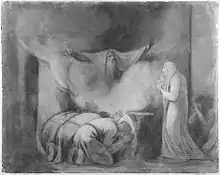Atossa
Atossa (Old Persian: Utauθa, or Old Iranian: Hutauθa; 550 BC - 475 BC) was an Achaemenid empress. She was a daughter of Cyrus the Great, and a sister-wife[1] of the Persian king of kings Cambyses II[2] and wife of Darius I.
| Atossa | |
|---|---|
| Queen of Achaemenid Empire | |
| Born | c. 550 BC |
| Died | 475 BC |
| Burial | |
| Spouse | Cambyses II Bardiya Darius the Great |
| Issue | Xerxes I Hystaspes Masistes Achaemenes |
| House | Achaemenid |
| Father | Cyrus the Great |
| Mother | Cassandane (?) |
| Religion | Zoroastrianism |
Name
The name "Atossa" (or "Atusa") means "bestowing very richly" or "well trickling" or "well granting". Atossa is the Greek (Ancient Greek: Ἄτοσσα) transliteration of the Old Persian name Utauθa. Her name in Avestan is Hutaosā.[3]
Life
Atossa was born in c. 550 BC.[3] She was eldest daughter of Cyrus the Great; her mother may have been Cassandane.[3] Atossa married her brother Cambyses II, probably after death of her father.
When Darius I defeated the followers of a man claiming to be Bardiya (Smerdis), the younger brother of Cambyses II in 522 BC, he married Atossa.[3] Atossa played an important role in the Achaemenid royal family, as she bore Darius the Great the next Achaemenid king, Xerxes I.
Atossa had a "great authority" in the Achaemenid royal house and her marriage with Darius I is likely due to her power, influence and the fact that she was a direct descendant of Cyrus.[3]
Herodotus records in The Histories that Atossa was troubled by a bleeding lump in her breast. A Greek slave, Democedes, excised the tumor.[4] This is the first recorded case of mastitis,[5] sometimes interpreted as a sign of an inflammatory breast cancer.[4]
Xerxes I was the eldest son of Atossa and Darius. Atossa lived to see Xerxes invade Greece. Being a direct descendant of Cyrus the Great, Atossa had a great authority within Achamenian imperial house and court. Atossa's special position enabled Xerxes, who was not the eldest son of Darius, to succeed his father.[3]
Literary references

Aeschylus included her as a central character in his tragedy The Persians. Atossa is also one of the major characters in the Gore Vidal novel Creation.
Atossa is also included in Herodotus' The Histories and is shown to be a strong woman with a lot of influence. He even goes as far as to suggest that her wanting a Greek maiden was a reason for why Darius the Great decided to begin his campaign to Greece.
In his history of cancer, The Emperor of All Maladies, Siddhartha Mukherjee imagines Atossa traveling through time, encountering different diagnoses and treatments for her breast cancer. Atossa becomes emblematic of cancer sufferers through history.[6]
Legacy
Minor planet 810 Atossa discovered by Max Wolf, is named in her honor.
The poet Matthew Arnold named his Persian cat ‘Atossa’. She is celebrated in his poem of 1882 called ‘Poor Matthias’, about the death of a pet canary.
References
- Boyce 1982.
- Boyce 1982, p. 78.
- Schmitt 1987, pp. 13–14.
- Mukherjee 2011, p. 41.
- Sandison, A. T. (1959). "The First Recorded Case of Inflammatory Mastitis— Queen Atossa of Persia and the Physician Democêdes". Medical History. 3 (4): 317–322. doi:10.1017/s0025727300024820. PMC 1034507. PMID 14441415.
- Mukherjee 2011, pp. 463–467.
Sources
- Boyce, Mary (1982). A History of Zoroastrianism: Volume II: Under the Achaemenians. Leiden: Brill. ISBN 9789004065062.
- Mukherjee, Siddhartha (2011). The Emperor of All Maladies: A Biography of Cancer. Harper Collins. ISBN 978-0-00-725092-9.
- Schmitt, R. (1987). "Atossa". Encyclopaedia Iranica, Vol. III, Fasc. 1. pp. 13–14.
